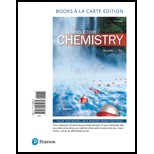
Concept explainers
Interpretation: Verify the atomic weight of the middle element in a triad is approximately the average of two. Along with this, explain the trend of melting points of hydrogen containing compounds like
Concept Introduction:
Atomic weight of an element is defined as the average of
Triad is a group of three elements, where the atomic weight of one of the element is the mean of the other two.
A solid consists of particles that possess high intermolecular forces of attraction. On absorption of heat, these forces tend to become weak and the attraction between molecules decreases. This led to the conversion of solid into liquid and the process is called as melting.
Want to see the full answer?
Check out a sample textbook solution
Chapter 12 Solutions
Introductory Chemistry, Books a la Carte Edition (6th Edition)
- A cylindrical piece of pure copper (d=8.92g/cm2) has diameter 1.15 cm and height 4.00 inches. How many atoms are in that cylinder? (Note: the volume of a right circular cylinder of radius r and height h is V=r2 h .)arrow_forwardArrange the following in the order of increasing mass. (a) a potassium ion, K+ (b) a phosphorus molecule, P4 (c) a potassium atom (d) a platinum atomarrow_forwardWithout doing any detailed calculations (but using aperiodic table to give atomic weights), rank the followingsamples in order of increasing numbers of atoms:0.50 mol H2O, 23 g Na, 6.0 * 1023 N2 moleculesarrow_forward
- How can I tell the charge of NaCH3COO, NaCl, and HCH3COO? Just in general I am not sure of how to determine the charge of compounds, so if that could be explained?arrow_forwardAn element Y reacts with Hydrogen to form a compound with a formula of HY. In which group in the periodic table is Y most likely to be found?arrow_forwardWithout doing any detailed calculations (but using aperiodic table to give atomic weights), rank the followingsamples in order of increasing numbers of atoms:0.50 mol H2O, 23 g Na, 6.0 x 1023 N2 molecules.arrow_forward
- calculate he equivalent weight of k2so4, if you know the atomic weight of k=39, s=32, o=16.arrow_forwardThe monatomic ions of Groups 1A(1) and 7A(17) are all singly charged. In what major way do they differ? Why?arrow_forwardWhich of the following elements would you expect to have similar properties? As Te Ar Sn Hearrow_forward
- How do I find the radii of an atom when the prompt provides its density and what element the atom is?arrow_forwardDiscussing this chapter, a classmate says, “Since elementsthat form cations are metals and elements that form anionsare nonmetals, elements that do not form ions are metalloids.”Do you agree or disagree?arrow_forwardPredict the chemical formulas of the compounds formed bythe following pairs of ions: (a) Cr3+ and Br-, (b) Fe3+ and O2-,(c) Hg22+ and CO32-, (d) Ca2+ and ClO3-, (e) NH4+ and PO43-.arrow_forward
 Chemistry & Chemical ReactivityChemistryISBN:9781337399074Author:John C. Kotz, Paul M. Treichel, John Townsend, David TreichelPublisher:Cengage Learning
Chemistry & Chemical ReactivityChemistryISBN:9781337399074Author:John C. Kotz, Paul M. Treichel, John Townsend, David TreichelPublisher:Cengage Learning Chemistry & Chemical ReactivityChemistryISBN:9781133949640Author:John C. Kotz, Paul M. Treichel, John Townsend, David TreichelPublisher:Cengage Learning
Chemistry & Chemical ReactivityChemistryISBN:9781133949640Author:John C. Kotz, Paul M. Treichel, John Townsend, David TreichelPublisher:Cengage Learning Chemistry: Principles and ReactionsChemistryISBN:9781305079373Author:William L. Masterton, Cecile N. HurleyPublisher:Cengage Learning
Chemistry: Principles and ReactionsChemistryISBN:9781305079373Author:William L. Masterton, Cecile N. HurleyPublisher:Cengage Learning World of Chemistry, 3rd editionChemistryISBN:9781133109655Author:Steven S. Zumdahl, Susan L. Zumdahl, Donald J. DeCostePublisher:Brooks / Cole / Cengage Learning
World of Chemistry, 3rd editionChemistryISBN:9781133109655Author:Steven S. Zumdahl, Susan L. Zumdahl, Donald J. DeCostePublisher:Brooks / Cole / Cengage Learning Introduction to General, Organic and BiochemistryChemistryISBN:9781285869759Author:Frederick A. Bettelheim, William H. Brown, Mary K. Campbell, Shawn O. Farrell, Omar TorresPublisher:Cengage Learning
Introduction to General, Organic and BiochemistryChemistryISBN:9781285869759Author:Frederick A. Bettelheim, William H. Brown, Mary K. Campbell, Shawn O. Farrell, Omar TorresPublisher:Cengage Learning




